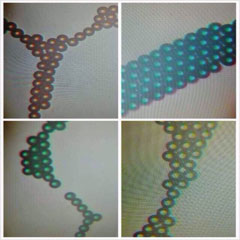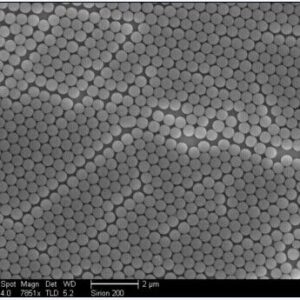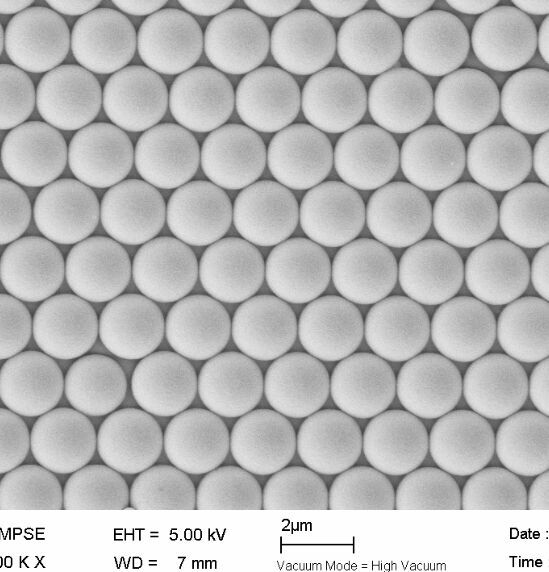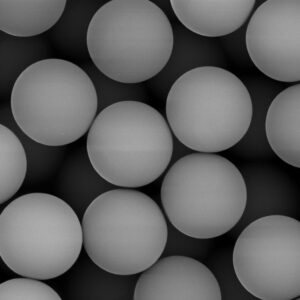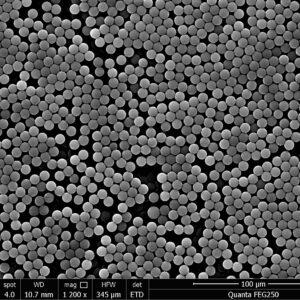产品分类
量子点聚苯乙烯微球
一、量子点聚苯乙烯微球描述
采用高亮度CdSe/ZnS量子点与聚苯乙烯通过微乳液聚合制备量子点聚苯乙烯微球(HQD),微球表面修饰羧基功能团以利于抗体偶联,通过纳米球包覆放大量子点的荧光信号,可显著提高免疫检测的灵敏度。
-300x237.png)
该荧光探针具有荧光信号稳定、胶体稳定性优良、生物相容性高的特点,特别适用于荧光体外诊断试剂的开发。该产品还可用于血流测量、生物标志物、活体成像及流式细胞仪的校准等。
羧化改性微珠表面具有高密度的游离羧酸,使其适合通过水溶性亚胺基试剂(如碳二酰亚胺(EDAC))与蛋白质和其他含胺生物分子进行共价偶联。
二、物理数据
1. 材料:聚苯乙烯微球包覆量子点
2.折射率:1.59@589nm,25℃
3、密度:1.05g/cm3
4. 特点: 荧光色
三、分析说明
1.固含量:1%(10mg/ml)
2. 粒径:100nm
3.均匀度:CV<5%
4.发射波长:610nm+10nm
5. 激发波长:<580nm,建议365nm-450nm
6.分散介质:去离子水及微量表面活性剂
7. 稳定性:出厂后2年
四、量子点聚苯乙烯微球的用途
我公司量子点纳米球(HQD610-10)表面富含羧基功能团,可以与含氨基的生物分子,如抗体、多肽、核酸等进行共价偶联,微球表面的羧基在活化剂1-(3-二甲氨基丙基)-3-乙基碳二酰亚胺盐酸盐(EDC)作用下,与氨基发生反应,形成稳定的酰胺键,从而将生物分子共价固定在纳米球表面。
使用注意事项:
○1 使用前请将QDNBs振荡混匀,长期放置产生少量沉淀属正常现象,不影响产品使用。
○2 为了达到更好的偶联效果,蛋白浓度应为0.5-4mg/mL,核酸浓度应为20-100μM,缓冲液中不能有游离氨基,尤其不能使用Tris、甘氨酸、乙酸、柠檬酸缓冲液。
所需材料:
○1 量子点纳米球(10mg/mL)。
○2 反应缓冲液(活化用):pH 4-6
○3活化剂:EDC·HCl。
○4 封闭液:1-2% BSA或casein。
○5保存液(pH7.0-7.5):20-100 mM 硼酸或 Tris,0.9% NaCl,0.5-1% BSA,0.09% NaN3。
参考耦合方案
○1 取约50 μl QDNBs悬浮液,分散于450 μl反应缓冲液中,12000-15000 rpm 离心10-30分钟,弃上清,将QDNBs分散于500 μl反应缓冲液中。
○2 加入偶联剂EDC(10mM)100-50μl,室温(25-37度)混匀,孵育0.5-1h。
○3 2000-15000rpm离心10-30min,除去多余的偶联剂等,再分散于500μl反应缓冲液中,超声分散;
○4 然后加入约100μg抗体(抗体与微球的比例需优化),室温(25-37度)混匀,孵育0.5-1h。
○51 2000-15000 rpm离心10-30分钟,去除游离抗体等;
○6 加入500μl封闭液,用超声波(功率10-20%)分散约10秒,室温(25-37度)下混匀,孵育0.5-1小时。
○7 离心,除去封闭液,分散于200 μl保存液中备用。
本实验方案仅供研究前期参考,具体实验条件请研究者根据自身项目情况进行优化。
| 产品编号 | 产品名称 | 粒度 |
| HQD610-150 | 量子点纳米珠 | 150纳米 |
| HQD610-10 | 量子点纳米珠 | 100纳米 |

